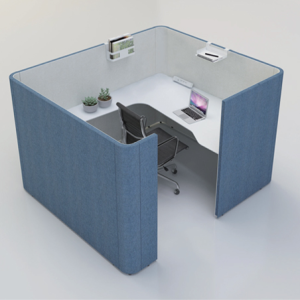Your chair plays an important role when it comes to workplace wellness.The right chair prevents injuries such as back pains and neck aches, allowing you to focus on work. And it doesn’t matter whether you’re working from home or the office; healthy sitting habits are mandatory anywhere.
While it’d be great to invest in an ergonomic chair, there are plenty of budget-friendly ways to optimise your normal chair. Here’s how to make your desk chair more ergonomic for your home or office set up:
1. Seat Cushion
A trusty seat cushion is one of the simplest ways to make your office chair more comfortable. It’s also the most cost effective! Look for a cushion that provides proper support to your lower back and promotes a neutral spine position.
Memory foam or gel cushions are excellent choices as they adapt to the shape of your body. This can reduce pressure points, enhancing comfort during long hours of sitting.
2. Lumbar Support
Preventing back pain at work is the main goal of ergonomic chairs. This usually comes in the form of its lumbar support, something standard office chairs lack. This can lead to lower back pains and in worst case scenarios, chronic issues.
Adding a lumbar support cushion or a roll pillow can be a game changer. It helps maintain the natural curvature of your spine similar to that of an ergonomic desk chair.
Position the pillow at your lower back to alleviate pressure and provide additional support.
3. Get a Chair Mat
If your workspace has carpeted flooring, it’ll probably be harder for you to roll around your chair. This makes a chair mat a worthwhile investment as it’ll give you a smooth surface to glide on.
A chair mat minimises friction, making it easier to move your chair while reducing strain on your legs. This should be much easier to incorporate into your home workstation while office goers may find it harder to implement in a shared office space.
It’s a matter that’s worth discussing nonetheless so consider taking it up to your manager. It may even encourage your employers to sponsor chair mats for everyone!
4. Adjustable Desk Height
If possible, adjust the height of your desk to ensure your arms and wrist are in a comfortable position when typing or using the mouse. Your elbows should be at a 90 degree angle and your wrists should be straight.
This helps prevent strain on your muscles, reducing the risk of developing conditions like carpal tunnel syndrome. However, not all desks have adjustable features but you can always adjust the next two items.
5. Chair Height
Check and adjust your chair to compliment your desk setup. Your feet should be flat on the floor and your knees should form a comfortable 90 degree angle.
Ensuring your chair is at the right height promotes proper posture by reducing stress on your lower back and legs. You should also fine tune the tilt of your chair to allow for a slight recline.
This contributes to a more ergonomic sitting position, distributing your weight evenly and providing better lumbar support.
6. Proper Monitor Height
Desk heights may not always be adjustable but your monitor certainly is. Adjust your monitor for optimal viewing by making sure it’s at eye level. This’ll prevent eye and neck strains especially during long hours of work.
Consider buying a monitor arm or a stand to help you achieve the desired height. You can even stack books below your monitor to elevate the screen. If you’re using a laptop, buy a laptop stand that offers proper elevation.
All these adjustments will help you maintain a neutral neck position, reducing the risk of discomfort and long term neck issues.
7. Footrests
If your chair lacks the adjustability to get your feet on the ground, consider using a footrest. This is especially useful if you have a higher desk or if you’re on the shorter side.
Adjust the footrest height to ensure a comfortable position so that it promotes proper posture and healthy blood circulation. A footrest can significantly reduce the pressure on your lower back and legs, making your chair more ergonomic.
8. Take Breaks, Move and Practise Healthy Habits
Office chair customisation is great and all but it’s equally important to get yourself moving after long periods of sitting. Take regular breaks and practise exercises that promote flexibility and relaxation.
Stand up, stretch and move around every 30 minutes to prevent stiffness and improve circulation. On that note, remember to cultivate healthy habits like sitting up right and not tilting your head forward.
Conclusion
Now that you know how to make your desk chair more ergonomic, it is advisable to start making changes immediately. The sooner you start, the better it’ll be for your body and work productivity.
However, we do recommend getting an ergonomic chair opposed to making these adjustments. Ergonomic chairs are built to maintain your posture and their benefits go well beyond standard office chairs.
So make the right choice and don’t forget to check out our wide range of Steelcase office chairs.







